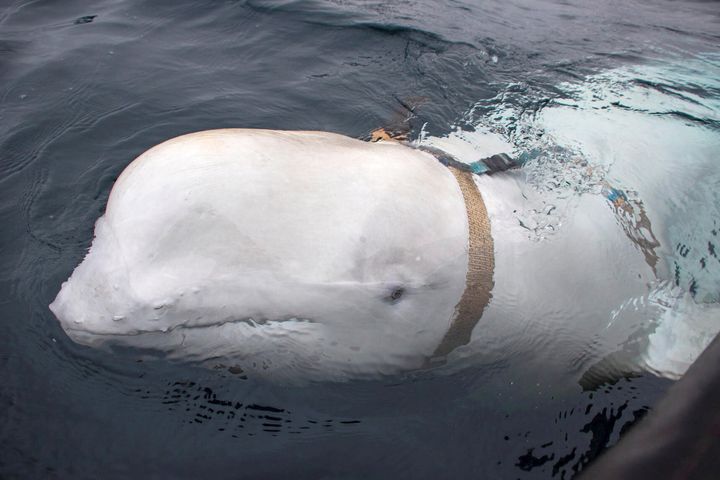
Yes, as surreal as it sounds, the marine mammal, known Hvaldimir, was allegedly trained by the Russian navy.
And, to the surprise of those monitoring him, he has recently moved with uncharacteristic speed away from his usual stomping (swimming?) grounds.
He was last spotted in Hunnebostrand near Sweden’s south-west coast on Sunday – a pretty long way away from where he was first seen back in 2019 near Norway.
At the time, he was wearing a harness made with mounts for a camera. It had the words “Equipment St Petersburg” printed on the plastic clasps, prompting speculation that he belonged to the Russian navy.
Marine biologists have since removed the harness, but he still can’t shake off claims he has a link to the Kremlin.
Even his name, given to him by Norway, is a pun on the word for whale in Norweigian, hval, and a nod to his suspected Russian connections.
Experts believe may have escaped an enclosure after being trained by Moscow, although Russia has never officially responded to speculation that he’s a spy gone rogue.
For a suspected undercover agent though, he’s not very discreet – he is known to follow boats and play with those on board.
Conservationists at the OneWhale organisation said that it was clear from the moment of his arrival that the whale “was a trained whale and pursued interactions with humans”.
The Norwegian Directorate of Fisheries have also previously explaining that he “tends to stay at farms where (he) has been able to catch fish, grazing on surplus feed” – which is why his sudden movements towards Sweden have been alarming.

Sebastian Strand, marine biologist with the OneWhale organisation, said: “We don’t know why he has sped up so fast right now.
“It could be hormones driving him to find a mate.
“Or it could be loneliness, as belugas are a very social species – it could be that he’s searching for other beluga whales.”
Thought to be between 13 and 14 years old, the whale is “at an age where his hormones are very high”.
OneWhale even has a Hvaldimir Hotline for the public to report sightings or concerns about the famous whale.
Its website reads: “He hunts fish and eats on his own, is no longer dependent on humans, and has done an amazing job surviving.
“However, Hvaldimir is not safe.
“Unfortunately, he is still in serious danger due to his surroundings.
“He is lonely and has no other whales for company, so he seeks the company of humans... this poses a danger not only to Hvaldimir but also to the humans who try to swim and interact with him.”
Hvaldimir is thought not to have seen another beluga whale since he first made the news back in 2019. The closest population of belugas is much further north than where he is now – it’s nearer the Svalbard archipelago, which lies between Norway and the north pole.
The whale is a protected species in Norway, and last Wednesday, when he was spotted on the move, Fisheries director Frank Bakke-Jensen urged the public to “keep a good distance” to avoid causing him any injuries.
